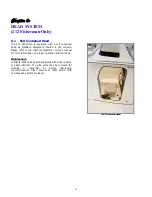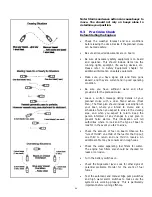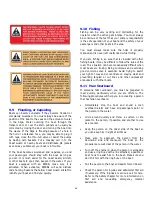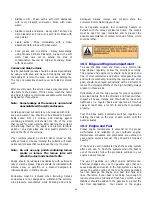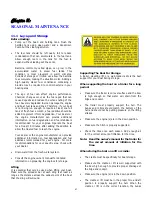
• Have a tool kit aboard. The kit should include the
following basic tools:
Hammer
Electrician’s
tape
Screwdrivers
Offset
screwdrivers
Lubricating oil
Pliers
Jackknife
Adjustable
wrench
Basic 3/8" ratchet set
Vise grip pliers
Hex key set
Needle nose pliers
Wire crimping tool
Wire connector Set
End wrench set
Medium slip-joint pliers
Diagonal cutting pliers
DC electrical test light
• Have the following spare parts on board:
Extra light bulbs
Spark plugs
Fuses and circuit breakers
Main 12-volt fuses
Assorted stainless screws
Assorted stainless bolts
Flashlight and batteries
Drain plugs
Engine oil and transmission oil Propellers
Fuel
filters
Propeller
nuts
Fuel hose and clamps
Wire ties
Engine cooling pump impeller Hydraulic steering oil
Assorted hose clamps
Rags
Steering fluid
Pump & alternator belts
• Make sure all fire extinguishers are in position and in
good operating condition.
9.4 Operating Your Boat
After Starting the Engines:
• Check the engine gauges. Make sure they are
reading normally.
• Visibly check the engines to be sure there are no
apparent water, fuel or oil leaks.
• Check the operation of the engine cooling systems
by inspecting the transom exhaust ports for water
flow.
• Check the steering and engine controls for proper
operation.
• Make sure all lines, cables, anchors, etc. for securing
a boat are on board and in good condition. All lines
should be coiled, secured and off the decks when
underway.
• Have a safe cruise and enjoy yourself.
Remember:
When you operate a boat, you accept the responsibility
for the boat, for the safety of passengers and for others
out enjoying the water.
• Alcohol and any drugs can severely reduce your
reaction time and affect your better judgment.
• Alcohol severely reduces the ability to react to
several different signals at once.
• Alcohol makes it difficult to correctly judge speed
and distance, or track moving objects.
• Alcohol reduces night vision, and the ability to
distinguish red from green.
• Make sure one other person on the boat is
instructed in the operation of the boat.
• Make sure the boat is operated in compliance with
all state and local laws governing the use of a boat.
• Always operate the blowers when operating the boat
below cruising speed or when the generator is
running to help cool the engine compartment.
• Avoid sea conditions that are beyond the skill and
experience of you and your crew. Learn to
understand weather patterns and indications for
change. You should monitor NOAA weather
broadcasts before leaving port and periodically while
boating. If the weather deteriorates or a storm
approaches, seek shelter in a safe harbor.
• Use caution during periods of reduced visibility due
to weather or operation conditions. Reduce speed
and designate a passenger to be a lookout for other
45
Summary of Contents for 180 Sportsman
Page 2: ...2...
Page 4: ...4...
Page 7: ...180 FISHERMAN SPECIFICATIONS 7...
Page 8: ...180 SPORTSMAN SPECIFICATIONS 8...
Page 9: ...202 FISHERMAN SPECIFICATIONS 9...
Page 10: ...212 FISHERMAN SPECIFICATIONS 10...
Page 18: ...18...
Page 39: ...SAFETY LABELS 2601 1124 39...
Page 40: ...180 FISHERMAN 180 SPORTSMAN CAPACITY LABELS 40...
Page 41: ...202 212 FISHERMAN CAPACITY LABELS 41...
Page 61: ...Appendix A SCHEMATICS 180 FISHERMAN INSTRUMENT PANEL 61...
Page 62: ...Appendix A SCHEMATICS 180 SPORTSMAN INSTRUMENT PANEL 62...
Page 63: ...Appendix A SCHEMATICS 202 212 FISHERMAN INSTRUMENT PANEL 63...
Page 68: ...Appendix A SCHEMATICS 180 FISHERMAN 180 SPORTSMAN TRAILER DRAWING 68...
Page 69: ...Appendix A SCHEMATICS 202 212 FISHERMAN TRAILER DRAWING 69...
Page 70: ...Appendix A SCHEMATICS 180 FISHERMAN OVERHEAD LAYOUT 70...
Page 71: ...Appendix A SCHEMATICS 180 SPORTSMAN OVERHEAD LAYOUT 71...
Page 72: ...Appendix A SCHEMATICS 202 FISHERMAN OVERHEAD LAYOUT 72...
Page 73: ...Appendix A SCHEMATICS 212 FISHERMAN OVERHEAD LAYOUT 73...
Page 77: ...MAINTENANCE LOG 77...
Page 78: ...MAINTENANCE LOG 78...
Page 80: ...Appendix D BOAT ACCIDENT REPORT 80...
Page 81: ...81...
Page 87: ...Appendix F TROUBLESHOOTING GUIDE 87...
Page 88: ...TROUBLESHOOTING GUIDE 88...
Page 89: ...TROUBLESHOOTING GUIDE 89...
Page 90: ...TROUBLESHOOTING GUIDE 90...
Page 91: ...TROUBLESHOOTING GUIDE 91...




